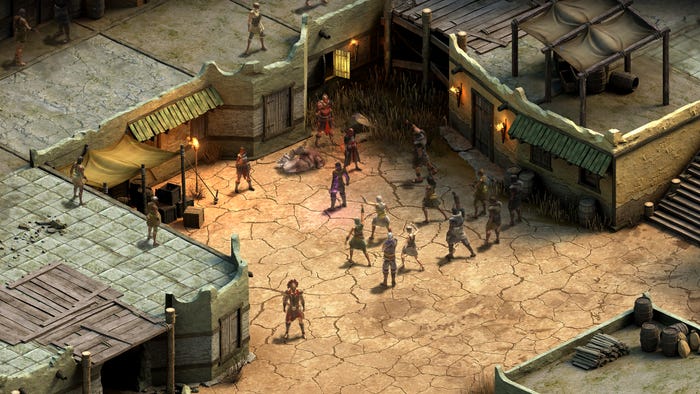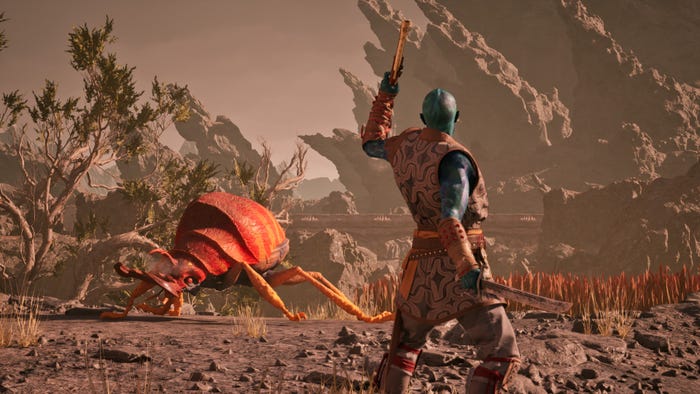Obsidian Leisure’s Avowed is a serious technical achievement for the fabled role-playing sport studio. Although the corporate has expertise with 3D motion RPGs like Fallout New Vegas and The Outer Worlds, Avowed brings the fantasy world of the corporate’s isometric Pillars of Eternity sequence to an enormous 3D world. Like its predecessors, Avowed permits gamers to make a dizzying variety of determination in gameplay and dialogue that each one intersect and form their journey. Mix these branching selections with the sport’s developments in first-person fight and animation, and you’ve got an exceptionally complicated sport liable to launching with a distressing variety of bugs.
However that did not occur. Avowed launched to essential acclaim, with some critics noting the sport is not as “glitchy” as lots of Obsidian’s beloved older titles. The studio’s repute for buggy video games was so noteworthy that on the 2025 Recreation Builders Convention, Obsidian QA lead David Benefield briefly talked about it in his presentation on Obsidian’s enhancements to its QA workflow.
What are these enhancements? In line with Benefield, Obsidian has spent the final decade (because the launch of 2016’s Tyranny) restructuring its QA division to work extra carefully with the remainder of the studio. QA testers grew to become QA analysts, and as an alternative of solely working exams on builds of video games like Avowed, the QA workforce started working with designers of all stripes to overview their work in Obsidian’s narrative instrument and Unreal Engine, recognizing bugs earlier than anybody hit the “commit” button.
That course of could sound dauting—however if you wish to bolster your QA workforce, Benefield stated you may boil the method down to at least one phrase: “prepare your QA workforce utilizing no matter strategies you are coaching your designers.”
Obsidian’s QA testers acquired entry to Tyranny’s narrative instruments
The yearslong journey to reinvent Obsidian’s QA division started in 2015 whereas creating the CRPG Tyranny. Dialogue in Tyranny is accompanied by portraits of characters in several premade “poses” that illustrate their emotional state. Initially these poses had been to be arrange by the narrative workforce working within the Obsidian narrative instrument, however based on Benefield, that workforce had change into slowed down creating quests and content material for the sport, and work on implementing poses was falling not on time.
Implementing these poses wasn’t a posh course of, it simply required hours and hours of labor, and the QA workforce had the bandwidth to take up the duty. However with entry to the instrument they started to appreciate there was masses of carried out content material they’d by no means seen or examined earlier than.
“We discovered strains that had by no means been examined, or, in some circumstances, strains you could not even attain as a participant as a result of a bug,” he stated. “Generally they had been total quest branches, small and huge, hidden inside these information that until you stumbled into it as a participant, or it was documented someplace, you would not know that it is even there, that means…QA could not [log] the bug if we did not know the bug was current.”

Picture through Obsidian Leisure/Paradox Interactive.
Benefield was a tester on the time, and whereas he was implementing poses, he noticed a probably game-breaking bug tied to the sport’s repute system. Within the sport’s opening hours, gamers stability calls for from completely different factions like “The Disfavored” and “The Scarlet Forest” to garner repute, culminating in a scene that can cement their preliminary allegiance. The scene checks the participant’s repute with every faction, which is calculated by numbers that go up or down relying on completely different selections. Whichever faction the participant has a greater repute with will decide what scene performs out and the way the sport progresses.
As a result of Benefield was working within the narrative instrument and will see the quantity values and narrative node pathways, he did the maths and located it was doable for gamers to make a exact set of selections that may finish with equal repute values with every faction. This was not an supposed end result, and the participant would not be capable of progress the story.
He confirmed the bug to his lead…who congratulated him on his initiative however stated they could not file a ticket until he reproduced it in a construct. It took him two hours to check and retest his principle, and the repair took 30 seconds. “I discovered it personally irritating to see I might discovered such a high-severity bug, however the price and time to breed it could show to be larger than the time to repair it,” he stated.
Thankfully, Obsidian listened to his suggestions, and after this Tyranny bumped the standing of its QA testers as much as QA analysts (growing their pay as effectively) and created a course of for analysts to overview quest and dialogue node timber earlier than they went into the construct.
Increasing in-tool testing on Avowed
Benefield took a couple of years away from Obsidian to work as a producer at Nexon, however was employed again on the firm as a QA lead on Avowed, the place he started extra rigorously implementing this course of. Avowed‘s dialog nodes weren’t bigger or extra complicated than Tyranny, however now the QA workforce additionally needed to monitor animation, audio, and different gameplay bugs that got here with first-person fight and animated conversations.
Utilizing a pattern dialog with a service provider from early in Avowed that checks if a particular social gathering member was current, Benefield confirmed 3 ways a mistake within the narrative instrument might result in a bug within the sport. If a designer created a node the place a “bark” (a line that happens with out dialogue UI) transitions right into a full dialogue sequence, the dialog breaks. If a designer forgets to establish a speaker when establishing a node, or the speaker was deleted after the file was created, the dialog breaks. And if somebody forgets to place a “crimson” discuss node (that ends the dialog) on the finish of their sequence, the dialog breaks. All three of those bugs got here up “dozens” of occasions when making Avowed, they usually’re “a lot simpler” to identify contained in the instruments than in the event that they’re reported from inside the sport.

Picture by Bryant Francis.
Within the strategy of catching these bugs and different logic breaks, the testing workforce started to identify extra superior (Benefield known as them “enjoyable”) scripting errors, recognizing them within the sport’s knowledge and flagging the narrative designer. This saved time for each groups since narrative designers now knew the foundation reason for a bug somewhat than being instructed the symptom. “It additionally saves QA time by discovering extra bugs-per-minute than in the identical time they’d spend testing content material within the sport.”
This course of wasn’t restricted to Obsidian’s in-house testers—exterior testers from service supplier QLOC had been additionally given this stage of entry. Testers from each corporations grew so proficient at working with the narrative instrument that Benefield started considering—what in the event that they utilized this course of to Unreal Blueprints as effectively?
Obsidian’s Unreal Engine designers embraced working with QA
After sufficient time with this new course of (and a wholesome vacation break), Benefield started drafting a pitch for the remainder of the studio. “If the analysts know these instruments so effectively, they usually know the sport so effectively, the one items they’re lacking are how triggers, set off volumes, and blueprints work on the Unreal aspect,” he argued. “So what if we acquired them that data too?”
The pitch triggered a little bit of “imposter syndrome” in Benefield. When he first joined Obsidian, the corporate’s org chart stored QA siloed away from the remainder of the design workforce, and there wasn’t numerous skilled overlap between the completely different ends of the corporate. There wasn’t a mandated divide such as you would possibly discover at different sport studios (this was the tail finish of an period the place some corporations forbade QA from ever talking with groups outdoors their division), but it surely wasn’t what you’d name a detailed relationship. Although the departments grew to become nearer over time, the lingering specter of viewing QA because the grunts on the backside of the group was nonetheless there.
Thankfully—and Benefield stated that is certainly one of his “favourite elements” of working at Obsidian—various designers shortly warmed as much as the thought, and had been keen to present it a shot. This led to the creation of the “joint evaluation session,” the place testers and designers stepped via a quest whereas reviewing the movement of data in Unreal.

Picture through Obsidian Leisure/Microsoft.
“As they undergo, the designer calls out each set off and script used on the hunt, actually pulling them up on a shared display screen for the analyst to see and ask questions,” Benefield stated. “We additionally file these so we will be very transient about our notes and actually simply deal with what’s on display screen.”
“As a result of QA is just ever seeing the way it does play out, this offers [designers] a possibility to say ‘wait, that is what it ought to have been doing, I did not understand that is a bug.'”
These conferences run for an hour (with a number of conferences scheduled if a quest takes longer). Generally bugs had been so apparent they might be fastened on a name.
Bringing QA and design collectively improved morale
In line with Benefield, Obsidian’s designers cherished these classes. Bugs had been squashed, QA realized extra about content material they wanted to check via standard means, manufacturing continued extra effectively, and possibly most significantly, it was a serious increase for morale.
“I did not see this one coming, but it surely was very noticeable to all people concerned and all people adjoining to those classes,” Benefield recalled. “People had been having fun with them. [Designers] felt significantly better about their quests after they’d been beat on throughout a joint evaluation session.
Even after these classes, designers and QA analysts had been extra snug reaching out to one another with questions and feedback.
Obsidian made various different enhancements to the QA course of through the making of Avowed, however all of them got here again to the core apply of coaching testers on instruments utilized by designers.
Although the workforce nonetheless used traditional “black field” testing to verify for bugs organically rising within the sport, this “white field” methodology introduced pleasure and collaboration to what is usually a grinding subject in sport improvement.
As Benefield concluded, “By pairing the QA mindset of ‘how do I get this to interrupt’ with the designer mindset of ‘how do I get this to work,’ we’re permitting these individuals to work carefully to one another, and we get a greater product in a shorter period of time.”
GDC and Recreation Developer are sibling organizations below Informa.



